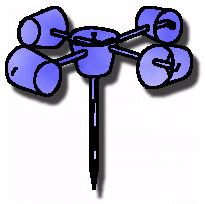|
I.
Prior Knowledge
Wind
is created when the Sun warms the Earth. The
warming is not even, because the poles receive less
heat. Convection currents soon form trying to even
out the temperature - this is the wind. The hotter
the Earth gets, the faster the convection currents
trying to cool it.
If
you are now going to try and build your own windmill
consider this:-
Focus
your attention on the ability of wind to make objects
move. Wind can do this because it has kinetic
energy or energy of movement. The faster the wind
blows, the more kinetic energy it has. This energy
is transferred when wind strikes an object, causing that
object to move.
Why
not list as many things as you can that are built to
catch the kinetic energy found in wind: sailboats,
kites, windsocks, gliders, pinwheels, WINDMILLS.
What do you know about windmills and their capacity to
catch atmospheric motion to make their blades
spin. How many different types of windmill designs
are familiar to you? You may want to surf around this
site and use the links to learn more about windmills.
II.
Exploration
Windmills
are designed to extract as much energy as possible from
the wind. Windmills capture the energy of the wind when
the wind moves the blades (or rotor) of the windmill. An
effective windmill must therefore be designed to capture
wind energy.
A.
Suggested Materials
-
Electric
fans
-
Assorted
pieces of wood
-
Cloth
for sails
III.
Explanation
There
are two basic classes of windmill design: horizontal
axis and vertical axis. Conventional windmills, spin on
a horizontal axis. The rotor, or spinning part of the
windmill, is the most important part because it
determines how much energy a windmill can capture and
then transform into some other form of energy.
The
rotating blades depend on either of two aerodynamic
principles to derive power from the wind: drag or lift.
Drag devices are simple wind machines that use flat,
curved or cup-shaped blades to turn the rotor. In these,
the wind merely pushes on the cup or blade, forcing the
rotor to spin.
Lift
devices, in contrast, use airfoils like those in the
wing of an airplane to propel the rotor. Air flowing
over the blade causes both lift and drag. As objects,
like an airplane's wings, move through the air, the air
pulls against them and holds them back. This is called
drag. Lift is caused by wind moving at different speeds
around the wing. Faster moving air has lower pressure
than slowly moving air. Slower air under the wing pushes
it upward as lift. The sum of these two forces on a
windmill's blades generates a thrust that pulls the
blade on its journey through the air, much like it pulls
a sailboat through the water. This thrust is greatest
when the blade is slicing through the wind. Airfoil
performance is determined by the ratio of lift to drag.
IV.
Examples From Everyday Life
A.
Cup-type Anemometer: four hemispherical cups attached to
radial arms which spin about a vertical shaft. These
anemometers measure wind speed by their revolutions per
minute. These devices work on the basis of aerodynamic
drag.

Make
Your Own Anemometer
When
you are driving down the road and you stick your hand
outside the car window, lift from the air flowing over
your hand (a crude airfoil shape) lifts your hand
towards the roof of the car. Drag pulls your hand
towards the rear of the car. The sum of these two forces
on any object generates a thrust that pulls that object
through the air.
WINDMILL
LINKS WIND
TURBINES WINDMILL
PROJECT
CONTACT:
nelson@solarnavigator.net
07905 147709 (UK)
|